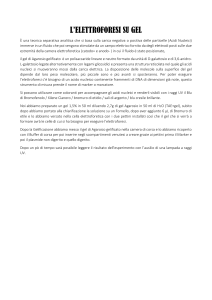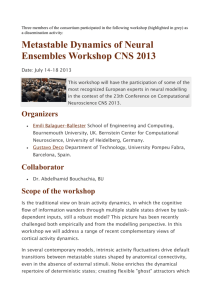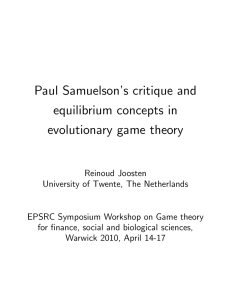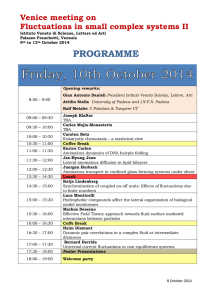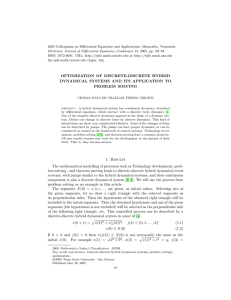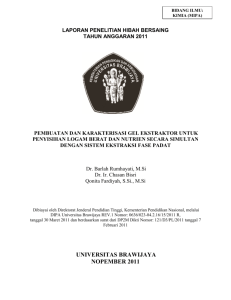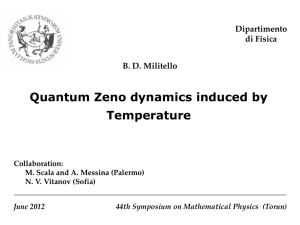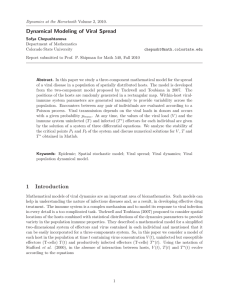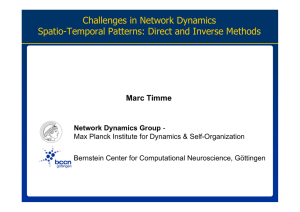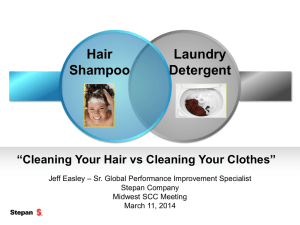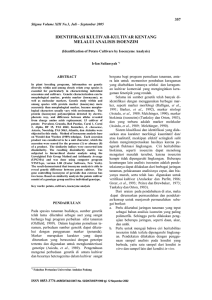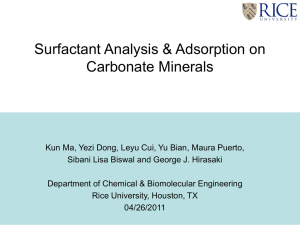Colloids in space
advertisement
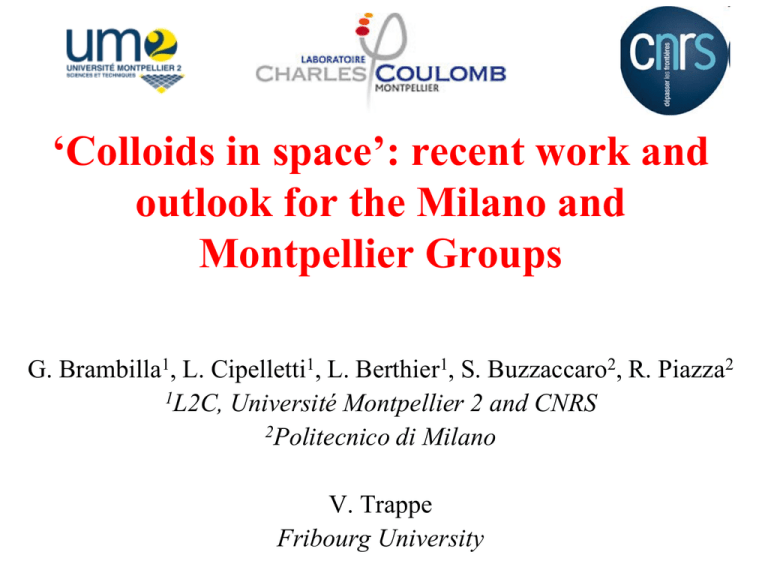
‘Colloids in space’: recent work and outlook for the Milano and Montpellier Groups G. Brambilla1, L. Cipelletti1, L. Berthier1, S. Buzzaccaro2, R. Piazza2 1L2C, Université Montpellier 2 and CNRS 2Politecnico di Milano V. Trappe Fribourg University Outlook 1) Research in Montpellier/Milano : Slow dynamics and dynamical heterogeneity in soft glasses / jammed materials. 2) Space Proposal: Solidification of colloids in space 3) Foam - C Dynamical heterogeneity is ubiquitous! Granular matter Keys et al. Nat. Phys. 2007 Colloidal Hard Spheres Weeks et al. Science 2000 Repulsive disks A. Widmer-Cooper Nat. Phys. 2008 CCD-based Dynamic Light Scattering sample CCD diaphragm Time Resolved Correlation (TRC) lag t degree of correlation cI(t,t) = time t < Ip(t) Ip(t +t)>p < Ip(t)>p<Ip(t +t)>p -1 Cipelletti et al. J. Phys:Condens. Matter 2003, Duri et al. Phys. Rev. E 2006 degree of correlation cI(t,t) = Average over t g2(t)-1 intensity correlation function g2(t) - 1 0.4 0.2 0.0 2 10 10 10 3 t (sec) g2(t) - 1 ~ f(t)2 4 10 10 5 Average dynamics < Ip(t) Ip(t +t)>p < Ip(t)>p<Ip(t +t)>p -1 degree of correlation cI(t,t) = < Ip(t) Ip(t +t)>p < Ip(t)>p<Ip(t +t)>p Average over t fixed t, vs. t intensity correlation function g2(t) - 1 fluctuations of the dynamics 0.4 cI(t,t)-1 g2(t)-1 -1 0.2 0.0 2 10 10 10 3 t (sec) g2(t) - 1 ~ f(t)2 10 4 10 5 0 10 4 2x10 4 t (sec) Average dynamics var[cI(t)] ~ c(t) 10mm Brownian particles 100mm Gillette Comfort Glide Foam Intensity correlation function Homogeneous vs heterogeneous dynamics Dynamical susceptibility Colloids close to rcp 0.4 c* 0.02 Supercooled liquid (Lennard-Jones) 0.2 0.01 g2(t)-1 var(cI) 0.3 0.1 0.00 0.0 2 10 3 4 10 10 t (sec) 5 10 Ballesta et al., Nature Physics 2008 • PVC in DOP • a ~ 5 µm • polidispertsity ~33% • j close to rcp Lacevic et al., Phys. Rev. E 2002 Speckle Visibility Spectroscopy By the group of Doug Durian Speckel contrast cI(t,t = 0) = < Ip(t) Ip(t)>p < Ip(t)>p<Ip(t)>p -1 Dynamics on the time scale of the CCD exposure time Pros: • “Light” algorithm (can be calculated on the fly) • Fast time scales (µsec – msec) Cons: • Time delays larger than the exposure time are not accessible • Need to adjust laser power to probe different time scales • Different time scales require separated runs Space-resolved DLS: Photon Correlation Imaging sample object plane Dq Dq lens focal plane CCD diaphragm image plane 2.3 mm Duri et al., Phys. Rev. Lett. 2009 q = 90° 1/q ~ 45 nm Local, instantaneous dynamics: cI( t, t, r) < Ip(t) Ip(t +t)>p(r) cI(t, t , r) = -1 < Ip(t)>p<Ip(t +t)>p(r) Note: << cI(t, t , r) >t>r = g2(t)-1 [g2(t)-1] ~ f(t)2 2.3 mm Dynamical Activity Maps: foam Dynamical Activity Map no motion 1.0 cI 0.0 cI (r, tw,t) DAM movie: 2x real time, 6.15 x 4.69 mm2 , lag t = 40 msec local rearrangement Dynamical Activity Maps: foam Dynamical Activity Map no motion 1.0 cI 0.0 cI (r, tw,t) DAM movie: 2x real time, 6.15 x 4.69 mm2 , lag t = 40 msec local rearrangement Random in time, correlated in space Sessoms et al., Soft Matter 2010 Strain field and µ-scopic dynamics Dynamics of actin/fascin networks D u rin g p olym erization strain field @lacem lateen tstages formation (d isp m ap o v erof 3 3 0network sec) Y coordinate (µ m ) 250 cos q , w h ere q is th e an gle w / resp ect to x ax is 200 -1.0 00 -0.8 00 0 150 -0.6 00 0 -0.4 00 0 100 -0.2 00 0 0 0 .2 0 00 50 0 .4 0 00 0 .6 0 00 0 0 .8 0 00 J. Kaiser, O. Lielig,, G. Brambilla, LC, A. Bausch, Nature Materials 2011 1 .0 0 0 0 100 200 300 40 0 5 µm 50 0 60 0 7 00 8 00 9 00 1000 1 10 0 1 20 0 1 30 0 X c oordinate (µ m ) A v erage d isplacem en t : 0 .7 5 µ m average strain field microcopic dynamics S tan dard d ev iatio n : 0 .48 µ m <Dr(t =330 s)> A ctinF ascin Jon aR 0 .1 _ n ig ht.av i: d ata tak en fro m F:\4 C A M S1 \Jo na\0 9 02 2 0_ sam ple4 \C C D 3 \N ig h t D isplacem en t m ap calcu lated for im ag es 3 9 3 5 an d 4 10 0 (M I0 0 00 1 .d at), co rresp on d in g to 1 05 1 0 sec after p rep arin g th e sam p le. bo x size 4 0 pixels, av erag e ov er 4 fram es, tim e lag is 3 30 sec. 1 pixel = 2 .2 µ m 0.1 4 10 time after preparing sample (sec) 10 5 age Dynamic Activity Maps: gels Colloidal gel g2(t)-1~ exp[-(t/tr)1.5] tr = 5000 s cI (t0,tr/10 , r) Movie accelerated 500x 2 mm 1.0 Onion gel Colloidal gel "Artificial skin", RH = 12% "Artificial skin" AS, RH = 62% Soft spheres, T = 24.5°C, j ~0.69 Soft spheres, T = 28°C, j ~0.57 Hard Spheres, j ~0.5468 Hard Spheres j ~0.5957 4 ~ G (Dr), G (Dr) Spatial correlation of the dynamics: x ~ system size in jammed soft matter! 4 0.5 0.0 0 2 4 Dr (mm) 6 Maccarrone et al., Soft Matter 2010 Space experiments ESA Proposal (2004): Solidification of Colloids in space: structure and dynamics of crystal, gel, and glassy phases Piazza (Milano), Van Blaaderen, Kegel (Utrecht), Cipelletti (Montpellier) Motivation for µ-g: - Solid like structures -> gravitational stress transmitted over large distances. - Mixture of particles with different r. - Slow dynamics -> long experiments, ISS Space experiments Original plan : investigate slow dynamics and DH in glassy colloidal systems (repulsive, attractive) Difficulty: only a limited set of samples will (hopefully) be flown Proposal: depletion force: a system with tunable (thermosensitive) attractive interactions DEPLETION EFFECTS IN COLLOIDS ADDING TO A SUSPENSION OF LARGE SPHERES SMALLER SPHERES (POLYMERS, SURFACTANT MICELLES)… FORCE VIEW SMALL SPHERES CANNOT ENTER HERE! Osmotic pressure unbalance yields an ATTRACTIVE force between colloids IF the depletant can be regarded as an IDEAL GAS AO POTENTIAL U = Vexc ENTROPY VIEW Large particles subtract free volume to the small ones (which DOMINATE ENTROPY) Small spheres gain entropy by PHASE SEGREGATION of the large colloids DEPLETANT: Triton X100 ● A nonionic surfactant forming globular micelles in a wide conc. range Hydrophilic head Hydrophobic tail r ≈3.4 nm Aggregation number N ≈ 100 ● When added to a MFA suspension, first adsorbs on the particles, leading to colloid stabilization even in the presence of salt ● At higher surfactant concentration: MICELLAR DEPLETION TO THE ROOTS OF GELATION 0.15 GELATION AS ARRESTED SPINODAL DECOMPOSITION GEL 0.10 s Miller & Frenkel coex. line for AHS 0.05 FLUID 0 SOLID 0 0.2 0.4 P 0.6 0.8 BIRTH OF A GEL Quenching into the L-L gap: FAST SEDIMENTATION (hours vs. months!) A MUCH MORE EXPANDED PHASE COMPRESSION MODULUS: A POWER LAW BEHAVIOR 1 3 B / k T 10 0 .1 0 .0 1 0 .0 5 0 .1 0 .2 0 .5 A) COLLAPSE OF DEPLETION GELS G. Brambilla, S. Buzzaccaro, R. P., L. Berthier, and L. Cipelletti (to appear in PRL) D) Collapse and ageing of a gel: macroscopic dynamics Time evolution of the gel height (P ≈ 0.12,Uatt ≈ 4.5 kBT ) Spinodal decomposition and cluster formation Settling of a cluster phase (linear in time) GELATION Poroelastic restructuring of an arrested gel THE POROELASTIC REGIME PICTURE: A FLUID (COUNTER)FLOWING THROUGH AN ELASTIC POROUS MEDIUM ● FORCE BALANCE: ( ) K ( ) = Drg t z z PERMEABILITY GRAVITATIONAL STRESS ● INPUT FOR NUMERICAL SIMULATIONS: i) K ( ) = ii) ( ) = 0 EFFECTIVE COMPRESSIONAL MODULUS IN RESPONSE TO AN APPLIED STRESS FROM STEADY-STATE PROFILE (1 - ) m WITH 0 AND m CHOSEN TO FIT THE TIME-DEPENDENCE OF THE GEL HEIGHT ELASTIC RESPONSE = a30.3 VELOCIMETRY LOCAL SETTLING VELOCITY v(t) (AT VARIOUS SETTLING TIMES) ● THE VELOCITY PROFILE IS ALMOST LINEAR FOR ANY SETTLING TIME, EXCEPT IN THE UPPERMOST LAYER OF THE GEL. t =30 h ● A z-INDEPENDENT (BUT t-DEPENDENT) STRAIN RATE: ( t ) = dv / dz t =80 h Collapse and ageing of a gel: microscopic dynamics Local TRC correlation functions in the gel SAME decay time at all values of z (like for strain rate!) t1/e scales as -1 B) CRITICAL DEPLETANTS (depletion vs. critical Casimir effect) S. Buzzaccaro, J. Colombo, A. Parola, and R. P. Phys. Rev. Lett. 105, 198301 (2010) COLLOID PHASE SEPARATION IN CRITICAL MIXTURES (Beysens & Estève, 1985) Beysens and Esteve, 1985 SURFACE TRANSITIONS (CRITICAL WETTING) Critical wetting layer ?NOT NECESSARILY LINKED TO BULK CRITICAL CASIMIR EFFECT SEPARATION Fisher - De Gennes 1978 Dietrich & coworkers (1998) C. Bechinger & coworkers (2008): Casimir forces pop up also when fluctuations are thermal instead of quantum, e. g. close to L-L demixing. Universal scaling of the force between a colloidal particle immersed in a critical binary mixture and the container walls TIRM measurements of forces between a silica plate and a polystyrene sphere dispersed in a critical liquid mixture. A “depletion” of critical fluctuations! ! Hydrophilic head DEPLETANT C12E8 - nonionic surfactant Hydrophobic tail • Forms globular micelles in a wide conc. range • Micellar radius r ≈ 3.4 nm → q = r/R ≈ 0.04 • Adsorbs on MFA, leading to steric stabilization • MICELLAR DEPLETION at larger surfactant concentration • PHASE SEPARATION WITH WATER BY RAISING T T L-L coexistence ≈ 70°C Globular Micelles LC EXPERIMENTAL RANGE ≈ 2% C12E8 concentration r ≈3.4 nm Aggregation number N ≈ 100 MINIMUM SURFACTANT AMOUNT TO INDUCE PHASE SEPARATION vs. T 70 C12E8/WATER COEXISTENCE GAP 60 PHASE SEPARATED T (C) 50 40 q-temperature 30 20 STABLE 10 0 2 4 6 volume fraction C12E8 8 10 SEPARATION vs. OSMOTIC PRESSURE 10 cs- cc =A2/3 cs - cc (% w/w) 5 2 1 0.5 0.2 T - Tc ≈ 4°C: has decreased by a factor of 200. Two orders of magnitude increase in depletion “efficiency 0.01 0.1 (cs, Ts) (104 Pa) 1 SEPARATION POINTS vs. x csep- cc (%) 10 1 csep - ccrit = ax- ; 0.1 1 2 1.8 5 x(csep, Tsep) [nm] 10 c sep - c c BUT: c sep - c c x 2/3 x - 1 .8 3 x 0 .3 T c - T ) ALMOST T-INDEPENDENT! 0.15 3 B x /k T 0.10 0.05 0 0 0 .2 4 8 2 x 10 12 What we would need to use Foam C Levels of confinement to be checked Stirring capability Temperature control would enable us to span a wide range of attractive forces with one single sample. T up to ~70°C, actual range/accuracy to be checked with R. Piazza Long runs: moderate frame rate (down to 10 Hz), tens of tau spanning several decades -> image storage and post processing. ~1 Gb / run, post processing time ~ 10'. Ground tests on the setup! Collaborators: V. Trappe (Fribourg) Students: P. Ballesta, G. Brambilla, A. Duri, D. El Masri Postdocs: S. Maccarrone, M. Pierno Funding: CNES, ESA, Région Languedoc Roussillon, ANR, MIUR. Thanks!
